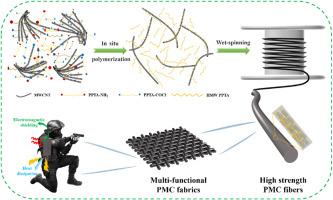Breaking the corrosive solvent paradigm: Scalable wet-spinning of PPTA/MWCNT composite fibers with unprecedented strength-functionality balance
IF 14.2
1区 材料科学
Q1 ENGINEERING, MULTIDISCIPLINARY
引用次数: 0
Abstract
Currently, the high performance and multifunctional integration of poly(p-phenylene terephthalamide) (PPTA) fibers are still facing the limitations of the use of corrosive solvents and the poor dispersion of functional fillers in the polymer matrix. Herein, PPTA prepolymers with controlled degrees of polymerization were designed as macromolecular monomers and co-dispersed with multi-walled carbon nanotubes (MWCNT) in a composite medium consisting of polar solvent and co-solvent to synthesize a high molecular weight PPTA/MWCNT (PMC) solution via in situ secondary polymerization. The non-covalent adsorption of MWCNT by the prepolymer molecules combined with a mild secondary polymerization process ensured the homogeneous dispersion of MWCNT in PPTA solution. Subsequently, the PMC solution was processed into fibers by an efficient and controllable wet spinning process, and the strength and modulus of PMC fibers were as high as 1.61 GPa and 51.5 GPa. Furthermore, the three-dimensional conductive-thermal network formed by MWCNT endowed PMC fabrics with an electromagnetic shielding effectiveness of 32.6 dB in the X-band and enhanced thermal conductivity by 58.2 % compared with pure PPTA fabrics. This work provides a scalable and environmentally benign strategy for manufacturing high-strength PPTA fibers and their multifunctional fabrics.

打破腐蚀性溶剂范式:PPTA/MWCNT复合纤维的可扩展湿纺,具有前所未有的强度-功能平衡
目前,高性能多功能一体化的聚对苯二甲酸乙二胺(PPTA)纤维仍面临腐蚀性溶剂使用和功能性填料在聚合物基体中分散性差的限制。本文将聚合度可控的PPTA预聚体设计为大分子单体,并与多壁碳纳米管(MWCNT)共分散在极性溶剂和助溶剂组成的复合介质中,通过原位二次聚合合成高分子量PPTA/MWCNT (PMC)溶液。预聚物分子对MWCNT的非共价吸附结合温和的二次聚合过程保证了MWCNT在PPTA溶液中的均匀分散。随后,通过高效可控的湿纺丝工艺将PMC溶液加工成纤维,PMC纤维的强度和模量分别高达1.61 GPa和51.5 GPa。此外,MWCNT形成的三维导热网络使PMC织物在x波段的电磁屏蔽效率达到32.6 dB,与纯PPTA织物相比,导热系数提高了58.2%。这项工作为制造高强度PPTA纤维及其多功能织物提供了一种可扩展和环保的策略。
本文章由计算机程序翻译,如有差异,请以英文原文为准。
求助全文
约1分钟内获得全文
求助全文
来源期刊

Composites Part B: Engineering
工程技术-材料科学:复合
CiteScore
24.40
自引率
11.50%
发文量
784
审稿时长
21 days
期刊介绍:
Composites Part B: Engineering is a journal that publishes impactful research of high quality on composite materials. This research is supported by fundamental mechanics and materials science and engineering approaches. The targeted research can cover a wide range of length scales, ranging from nano to micro and meso, and even to the full product and structure level. The journal specifically focuses on engineering applications that involve high performance composites. These applications can range from low volume and high cost to high volume and low cost composite development.
The main goal of the journal is to provide a platform for the prompt publication of original and high quality research. The emphasis is on design, development, modeling, validation, and manufacturing of engineering details and concepts. The journal welcomes both basic research papers and proposals for review articles. Authors are encouraged to address challenges across various application areas. These areas include, but are not limited to, aerospace, automotive, and other surface transportation. The journal also covers energy-related applications, with a focus on renewable energy. Other application areas include infrastructure, off-shore and maritime projects, health care technology, and recreational products.
 求助内容:
求助内容: 应助结果提醒方式:
应助结果提醒方式:


